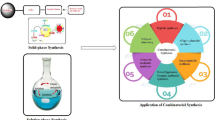Abstract
Standard chemistry prescribes the conversion of one or two compounds into their products. In contrast, Eintopf (one-pot) multicomponent reactions (MCRs) involve at least three different compounds. One-pot MCRs are a useful tool in combinatorial chemistry: From a mixture of educts a large number of products can be simultaneously formed in liquid phase, called a soluble molecular library. The member compounds of such libraries are investigated simultaneously for desired properties, e.g. antibiotic activity.
The main constraint is, that the underlying chemistry must not produce unknown side reactions and must lead to a broad spectrum of stable products with high yields.
Isocyanide multicomponent chemistry allows the generation of soluble libraries of very different sizes, which are easy to screen for biological or pharmaceutical efficacy using the algorithms presented. Products can easily be enumerated and the kinetics of the isocyanide chemistry is simple to investigate.
Combinatorial chemistry is capable of generating and optimizing leads faster and with fewer resources than by conventional means. Combinatorial chemistry based on isocyanide chemistry is by far the most important and most impressive technique in use today to reducing time and costs associated with lead generation and optimization during the drug discovery process. The simplicity of the reaction conditions involved means that the generation and screening of libraries can be automated.
Similar content being viewed by others
References
I. Ugi, A. Dömling, and W. Hörl, Endeavour 18, 115 (1994).
I. Ugi and C. Steinbrückner, Chem. Ber. 94, 734 (1961). (b) I. Ugi, Isonitrile Chemistry, Academic Press, New York, 1971, p. 149.
S.Y. Seuny and W.C. Still, Angew. Chem. 106, 2517 (1994).
D.W. Gordon and J. Steele, Biorganic and Medicinal Chemistry Letters 5, 47 (1994).
M. Pátek, B. Drake and M. Lebl, Tetrahedron Lett. 35, 9169 (1994).
S. Hobbs DeWitt, J.S. Kiely, C.J. Stankovic, M.C. Schroeder, D.M. Reynolds Cody, and M.R. Pavia, Proc. Natl. Acad. Sci. USA 90, 6909 (1993).
M.J. Kurth, L.A. Ahlberg Randall, C. Chen, C. Melander, and R.B. Miller, J. Org. Chem. 59, 5862 (1994).
L. Weber, Nachr. Chem. Tech. Lab. 42, 698 (1994).
C. Chen, L.A. Ahlberg Randall, R.B. Miller, A.D. Jones, and M.J. Kurth, J. Am. Chem. Soc. 116, 2661 (1994).
M. Vincent et al., Tetrahedron Lett. 23, 1677 (1982); R. Patchett et al., Nature 288, 280 (1980).
I. Ugi, Angew. Chem. 94, 826 (1982); I. Ugi, Angew. Chem. Int. Ed. 21, 810 (1982).
G. Gokel et al., Academic Press, New York, 1971, p. 201; A. Failli, H. Immer, and M. Götz, Can. J. Chem. 57, 3257 (1979).
M. Almstetter, Diploma Thesis, Technical University of Munich, 1995.
A. Demharter, Doctoral Thesis, Technical University of Munich, 1993.
S. Fushiya, S. Yamada, M. Matsuda, and S. Nozoe, Tetrahedron Lett. 35, 8201 (1994).
E. Haslinger, Monatsh. Chem. 109, 749 (1978).
R. Bossio, S. Marcaccini, P. Paoli, and R. Pepino, Synthesis 672 (1994).
M. Göbel and I. Ugi, Tetrahedron Lett. 36, 6043 (1995).
A. Dömling and I. Ugi, Angew. Chem. 105, 634 (1993); A. Dömling and I. Ugi, Angew. Chem. Int. Ed. 32, 563 (1993).
A. Dömling, Doctoral Thesis, Technical University of Munich, 1993.
K. Heyns and R. Hohlweg, Chem. Ber. 111, 1632 (1978).
R.D. Guthrie and R.W. Irvine, Carbohydr. Res. 82, 225 (1980).
G. Grewal, N. Kaila, and R.W. Franck, J. Org. Chem. 57, 2084 (1992).
I. Ugi, A. Dömling, B. Gruber, M. Heilingbrunner, C. Heiß and W. Hörl, Bitterfeld, Germany, 1994.
Author information
Authors and Affiliations
Additional information
Professor Ivar Ugi has the Chair of Department I of the Institute for Organic Chemistry and Biochemistry at the Technical University of Munich.
Rights and permissions
About this article
Cite this article
Ugi, I., Goebel, M., Gruber, B. et al. Molecular libraries in liquid phase via UGI-MCR. Res. Chem. Intermed. 22, 625–644 (1996). https://doi.org/10.1163/156856796X00115
Received:
Accepted:
Issue Date:
DOI: https://doi.org/10.1163/156856796X00115




